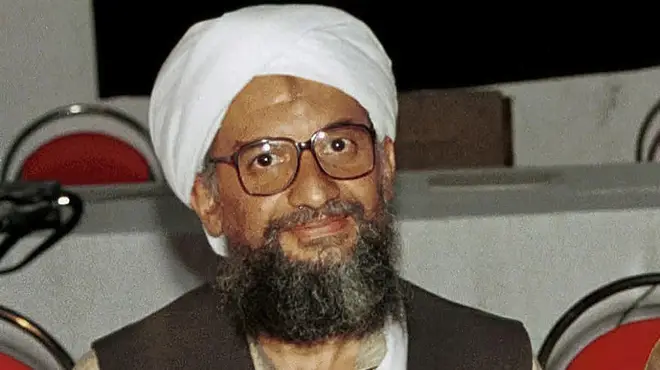
Richard Spurr 1am - 4am
2 August 2022, 09:44

US officials built a scale model of the house where Ayman al-Zawahri had been located and brought it into the White House to show President Joe Biden.
The White House has revealed the painstaking efforts that went into planning the drone strike that killed Ayman al-Zawahri.
On Sunday two Hellfire missiles fired by a US drone ended al-Zawahri’s decade-long reign as the leader of al Qaida.
The counterterrorism operation that saw al-Zawahri killed as he stood on the balcony of his Kabul safe house was the result of many months of careful planning.
US officials had built a scale model of the house where al-Zawahri had been located, and brought it into the White House Situation Room to show President Joe Biden.
They knew al-Zawahri was partial to sitting on the home’s balcony.
They had painstakingly constructed “a pattern of life,” as one official put it.
They were confident he was on the balcony when the missiles flew, officials said.

Years of efforts by US intelligence operatives under four presidents to track al-Zawahri and his associates paid dividends earlier this year, Mr Biden said, when they located Osama bin Laden’s longtime number two, a co-planner of the September 11 2001, terrorist attacks on the US and ultimate successor, at the house in Kabul.
Al-Zawahri’s family, supported by the Haqqani Taliban network, had taken up residence in the home after the Taliban regained control of the country last year, following the withdrawal of US forces after nearly 20 years of combat that had been intended, in part, to keep al Qaida from regaining a base of operations in Afghanistan.
But the lead on his whereabouts was only the first step.
Confirming al-Zawahri’s identity, devising a strike in a crowded city that would not recklessly endanger civilians, and ensuring the operation would not set back other US priorities took months.
It involved independent teams of analysts reaching similar conclusions about the probability of al-Zawahri’s presence, the scale mock-up and engineering studies of the building to evaluate the risk to people nearby, and the unanimous recommendation of Mr Biden’s advisers to go ahead with the strike.
Mr Biden called the evidence “clear and convincing”.
“I authorised the precision strike that would remove him from the battlefield once and for all,” he said.
“This measure was carefully planned, rigorously, to minimise the risk of harm to other civilians.”
Mr Biden ordered what officials called a “tailored airstrike”, designed so that the two missiles would destroy only the balcony of the safe house where the terrorist leader was holed up for months, sparing occupants elsewhere in the building.
A senior US official, speaking on the condition of anonymity to discuss the strike planning, said al-Zawahri was identified on “multiple occasions, for sustained periods of time” on the balcony where he died.
The official said “multiple streams of intelligence” convinced US analysts of his presence, having eliminated “all reasonable options” other than his being there.

Two senior national security officials were first briefed on the intelligence in early April, with the president being briefed by national security adviser Jake Sullivan shortly afterwards.
Through May and June, a small circle of officials across the government worked to vet the intelligence and devise options for Mr Biden.
On July 1 in the White House Situation Room, after returning from a five-day trip to Europe, Mr Biden was briefed on the proposed strike by his national security aides.
It was at that meeting, the official said, that Mr Biden viewed the model of the safe house and questioned advisers, including CIA Director William Burns, director of National Intelligence Avril Haines and National Counterterrorism Centre director Christy Abizaid, about their conclusion that al-Zawahri was hiding there.
Mr Biden, the official said, also pressed officials to consider the risks the strike could pose to American Mark Frerichs, who has been in Taliban captivity for more than two years, and to Afghans who aided the US war efforts who remain in the country.
US lawyers also considered the legality of the strike, concluding that al-Zawahri’s continued leadership of the terrorist group and support for al Qaida attacks made him a lawful target.
The official said al-Zawahri had built an organisational model that allowed him to lead the global network even from relative isolation.
That included filming videos from the house, and the US believes some may be released after his death.
On July 25, as Mr Biden was isolated in the White House residence with Covid-19, he received a final briefing from his team.
Each of the officials participating strongly recommended the operation’s approval, the official said, and Mr Biden gave the sign-off for the strike as soon as an opportunity was available.
The opportunity came early on Sunday, late Saturday in Washington.

A further 36 hours of intelligence analysis would follow before US officials began sharing that al-Zawahri was killed, as they watched the Haqqani Taliban network restrict access to the safe house and relocate the dead al Qaida leader’s family.
US officials interpreted that as the Taliban trying to conceal the fact they had harboured al-Zawahri.
After last year’s troop withdrawal, the US was left with fewer bases in the region to collect intelligence and carry out strikes on terrorist targets.
It was not clear from where the drone carrying the missiles was launched or whether countries it flew over were aware of its presence.
The US official said no US personnel were on the ground in Kabul supporting the strike and the Taliban was provided with no forewarning of the attack.